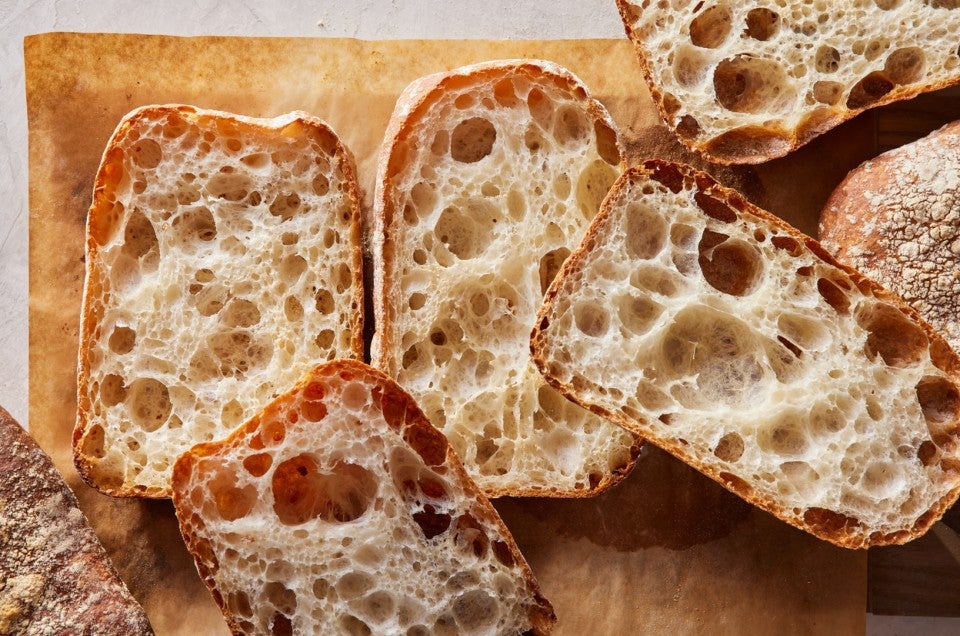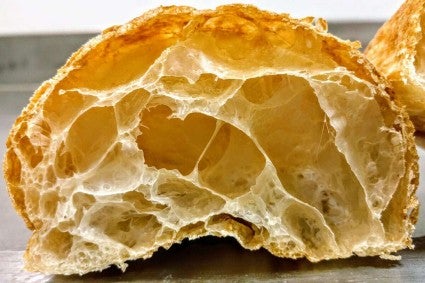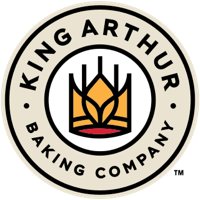Glass bread tastes as good as it looks (and it looks really, really good)
A beautiful bread made possible by bread flour.


 Recently I saw a loaf that stopped me in my tracks. It was a loaf that looked like it had all the qualities of a great bread: flavor, texture, sustenance. And most of all, beauty. Beauty, after all, is half the reason I bake. (Haven't you ever made something just because it’s gorgeous?)
Recently I saw a loaf that stopped me in my tracks. It was a loaf that looked like it had all the qualities of a great bread: flavor, texture, sustenance. And most of all, beauty. Beauty, after all, is half the reason I bake. (Haven't you ever made something just because it’s gorgeous?)
That loaf turned out to be Pan de Cristal, a traditional loaf from the Catalan region of Spain sometimes referred to as "glass bread." The outside of this loaf is unassuming — dark and crusty — and not exactly a showstopper. But wait. Hidden inside, lurking like crystals underneath a crust so crisp it seems fried, is a miraculously beautiful crumb. Threads of gluten stretch into glassy, translucent webs. Is it bread, I thought, or is it treasure?

It's both. And that’s what drew me in. I started asking questions: What magic makes Pan de Cristal possible? Will the recipe require days of attention, special flours, or mystical hands to transform four simple ingredients?
Luckily, I found the answers.
When I explore something new, I always start with architecture. In baking terms, what I mean is that I look inside the loaf at the structural components and ingredient ratios. I also consider method — the mixing, fermentation, and baking — and come up with a list of questions. You’ve seen me do this before from chocolate bread hacks to twists on traditional favorites.
The hydration will need to be dangerously high, around 100% in baker’s percentages (meaning, equal weights of flour and water). Compare this with baguettes (in the range of 65% to 75%) or ciabatta (around 80%), and you may be concerned. I don’t blame you. As designed, the dough will feel more like a batter than bread.
For leavening, I choose commercial yeast. The acidity of a sourdough culture isn't the flavor profile that I want. Let’s keep it simple: malty wheat, a well-baked crust, a drizzle of olive oil. Plus, I have time goals: I’d love to make this bread in a single afternoon. No preferment and a little commercial yeast will speed up the process.
Then there's fermentation. The dough will need time and folds to develop the necessary strength for its final proof. I'm not sure how much of each, but I do know that we’re chasing miracles here. This brings me to the crux of the challenge: How will it be possible to push this wet dough to the edge of its rise without collapsing?
Here’s how: Bread flour.

Sometimes baking requires a superhero. Bread flour, with enough strength to hold tons of water and support a long final proof without collapsing, is the caped hero we need. All-purpose could work but I would need to lower the hydration, sacrificing a key requirement for Pan de Cristal’s signature open structure.
Bread flour is also integral to creating a dough that's smooth, silky, and workable, despite the high hydration.
Early attempts involved yeasted preferments and lots of mechanical mixing. While the bread I made was flavorful, the crumb wasn’t much better than my ciabatta. Back to the drawing board.
First up, I needed to fix the most defining characteristic for this loaf: the holes. Since a long process with extensive mixing didn’t produce what I wanted, I went in the opposite direction: less mixing and a shorter process. My thought was that too much strength as a result of either development (mixing, folding, or time being the contributing factors) or fermentation, made my crumb structure too homogenous, not wildly open.
After several bakes with adjustments to mixing, number of folds, length of fermentation, and final rise, I found myself getting closer. The holes started to open, creating a collage of glassy, translucent bubbles, all connected within a network of random threads. The crust became thinner and crispier as I pushed the final rise further and further. As my cutting board was taken over by the piles of loaves, I began cutting them open as a parlor trick, shocking my family with the incredible results.
But rather than taking a bow after, “Wow, daddy, that’s amazing,” let’s give credit where it’s due. Please stand, a round of applause for bread flour — strong, elastic, ready for all the water and fermentation we can throw at it — the true star of this show.
So, if you'd like to see this transformation in action, give the recipe a whirl. Mix the dough just before noon, fold a few times between errands, Zoom meetings, dinner preparation, and life, and you'll have a hero at the table by dinnertime. Cue the applause!

In testing, enjoying, and sharing many loaves of Pan de Cristal, here are some things that I found helpful.
Just keep folding. On the flip side, if your dough doesn't match my above video exactly, or if you feel like it's more suited for pancakes than Pan, keep going. Unless there's a mistake with your measurements of flour or water, and as long as you're using great flour, the dough will definitely come around.
If you make this Pan de Cristal, please let us know — tag your photos #bakeoftheweek and maybe give @kingarthurbaking a shout-out, too. Happy baking!


September 6, 2023 at 8:49pm
I just made my first batch. Flavor, crisp chewy crust, tender crumb. It didn't rise like I expected. The 80 minute rise overfilled the 9 inch pan, sticking to the covering pan. It really spread out when I took it out of the pan. It made large loafs that were thinner, smaller holes. Any suggestions for next time?
September 9, 2023 at 3:41pm
In reply to I just made my first batch… by Judy (not verified)
July 12, 2023 at 9:50pm
The bread came out fluffly, very tasty but not large holed. I used the high protein flour instead of bread flour. Would that cause the holes not be be big. I did get a great rise and I was surprised when I cut it open to see the size of the holes.
July 15, 2023 at 12:18pm
In reply to The bread came out fluffly,… by Renee Zonka (not verified)
Hi Renee, using a higher protein flour might well result in the high rise, but less open crumb structure you experienced. This is because a higher protein flour will both develop a stronger gluten network, but also absorb more water than the Bread flour called for. A slightly stiffer dough with a tighter gluten network will still yield an excellent rise, but the airiness will likely be more evenly distributed in smaller, more regular air cells.
June 27, 2023 at 12:01am
Question: Does using a fan/convection oven alter the time or baking temperature?
June 28, 2023 at 9:37am
In reply to Question: Does using a fan… by Phyllis (not verified)
It certainly does, Phyllis! According to our blog on this topic, we recommend reducing your baking temperature by 25 degrees and checking for doneness 10 minutes earlier. Happy baking!
June 17, 2023 at 8:49pm
I made this bread today. I did everything exactly as the recipe called for and spent all day babysitting a soupy dough that I was convinced was never going to become bread. Then, I baked it. Holy Cow! The bread was perfect. The crispest crust and the softest inside with so many little air holes! I absolutely could not believe it! This recipe is a miracle—and a keeper!!
June 18, 2023 at 10:13am
In reply to I made this bread today. I… by Judy S (not verified)
That's so great to hear, Judy! Thanks for sharing your results!
March 19, 2023 at 4:38pm
This is my favorite bread recipe now. I've been baking high hydration sourdough breads for a few years now, and this seemed like a challenge that I was up to. In my first batch, I used commercial yeast. I baked another one today that I made from sourdough levain. Here is my question:
If my dough weighs 454 grams going into the oven, how many grams is your final pan de cristal after baking and cooking to room temperature? In other words, what is your % moisture loss on pan de cristal?
March 21, 2023 at 7:45pm
In reply to This is my favorite bread… by Kenneth Hesser (not verified)
Hi Kenneth! We haven't obtained a consistently standard measurement here but the dough generally weighs between 80-85% of the original dough weight (363-385g) prior to being proofed and baked. Happy baking!
Pagination